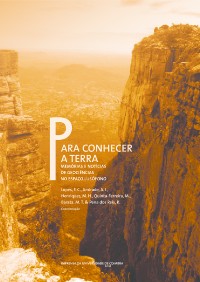Please use this identifier to cite or link to this item:
https://hdl.handle.net/10316.2/31399| DC Field | Value | Language |
|---|---|---|
| dc.contributor.author | Batezelli, A. | |
| dc.date.accessioned | 2014-06-19T15:57:08Z | |
| dc.date.accessioned | 2020-09-18T16:04:06Z | - |
| dc.date.available | 2014-06-19T15:57:08Z | |
| dc.date.available | 2020-09-18T16:04:06Z | - |
| dc.date.issued | 2012 | - |
| dc.identifier.isbn | 978-989-26-0534-0 (PDF) | |
| dc.identifier.uri | https://hdl.handle.net/10316.2/31399 | - |
| dc.description.abstract | With the end of the Eocretaceous volcanic manifestations (133 Ma), the southeastern portion of the South American Plate underwent tectonic restructuring, which generated basins that encompassed continental sedimentary sequences. The tectonic events responsible for the accumulation of such sequences can be divided in two main phases. The first phase is related to the Eocretaceous thermal subsidence, resulting in the formation of the Caiuá basin. The second phase, during which the Bauru Basin was originated, was related to the Neocretaceous uplifts in southwestern Minas Gerais and southern Goiás, related to the magmatic activities. The analyses showed that the Caiuá Basin is characterized by a depression whose depocenter was located to the south. At that time, the climate was arid, as attested by the aeolian sedimentation. The Bauru Basin, generated in the Neocretaceous and with depocenter located to the northern, encompasses playa-lake and alluvial deposits of arid to semi-arid climate, with sedimentological and paleopedological characteristics suggestive of more humid climatic conditions. By means of stratigraphic analysis based on wells and outcrops and aided by petrographic studies, two surfaces were identified that record important changes in the Bauru Basin tectonic and paleoenvironmental conditions. The first, related to the origin of the Bauru Basin, marks the tectonic restructuring that affected the southeastern portion of the South American Plate. It separates the Eocretaceous desertic system tract from the Neocretaceous lacustrine/playalake/ alluvial system tract. The second surface at the top of the lacustrine/playa-lake sequence records changes in the tectono-sedimentary, as well as paleoenvironmental and paleoclimatic conditions | eng |
| dc.description.abstract | Com o término das manifestações vulcânicas eocretáceas (133 Ma), a porção Sudeste da Placa Sul-americana passou por um processo de reestruturação tectônica gerando bacias que abrigaram sequências sedimentares continentais. Os eventos tectônicos responsáveis pelo acúmulo dessas sequências podem ser divididos em duas fases principais. A primeira fase está relacionada à formação da Bacia Caiuá, enquanto que a segunda, é marcada pela Bacia Bauru. Análises sedimentológicas e estratigráficas mostraram que a Bacia Caiuá (Eocretáceo) foi caracterizada por uma depressão cujo depocentro estaria localizado na porção mais ao sul da placa Sulamericana, no estado do Paraná. Nessa época, o clima era árido, atestado por uma sedimentação eólica. A Bacia Bauru, gerada no Neocretáceo, apresenta depocentro situado entre o oeste de São Paulo e sudoeste de Minas Gerais, abrigando depósitos lacustres rasos e aluviais de clima árido a semi-árido, com características sedimentológicas e paleopedológicas sugestivas de condições climáticas mais úmidas. Através da análise estratigráfica, baseada em poços e afloramentos, associados aos estudos petrográficos, foram identificadas duas superfícies que registram importantes mudanças nas condições tectônicas e paleoambientais da Bacia Bauru. A primeira, relacionada com a origem da Bacia Bauru no Cretáceo Superior, marca a reestruturação tectônica pela qual a porção sudeste da Placa Sul-Americana foi submetida. Esta superfície separa o trato de sistemas desértico eocretáceo do trato de sistemas lacustre/aluvial neocretáceo. A segunda superfície, no topo da sequência lacustre, registra mudanças nas condições tectonossedimentares, bem como, paleoambientais e paleoclimáticas | por |
| dc.language.iso | por | - |
| dc.publisher | Imprensa da Universidade de Coimbra | por |
| dc.relation.ispartof | http://hdl.handle.net/10316.2/24406 | por |
| dc.rights | open access | - |
| dc.subject | South American Plate | eng |
| dc.subject | Continental system tracts | eng |
| dc.subject | Facies | eng |
| dc.subject | Paleosols | eng |
| dc.subject | Paleoclimatic conditions | eng |
| dc.subject | Placa Sul-americana | por |
| dc.subject | Tratos de sistemas continentais | por |
| dc.subject | Fácies | por |
| dc.subject | Paleossolos | por |
| dc.subject | Condições paleoclimáticas | por |
| dc.title | Evolução dos tratos de sistemas continentais neocretáceos da porção sudeste da plataforma sul-americana | por |
| dc.title.alternative | Neocretaceous continetal systems tracts evolution of southeast south american plate | eng |
| dc.type | bookPart | por |
| uc.publication.firstPage | 111 | - |
| uc.publication.lastPage | 121 | - |
| uc.publication.location | Coimbra | por |
| dc.identifier.doi | 10.14195/978-989-26-0534-0_11 | - |
| uc.publication.digCollection | PB | por |
| uc.publication.orderno | 11 | - |
| uc.publication.area | Artes e Humanidades | por |
| uc.publication.bookTitle | Para conhecer a Terra: memórias e notícias de Geociências no espaço lusófono | - |
| uc.publication.manifest | https://dl.uc.pt/json/iiif/10316.2/31399/218371/manifest?manifest=/json/iiif/10316.2/31399/218371/manifest | - |
| uc.publication.thumbnail | https://dl.uc.pt/retrieve/11293042 | - |
| uc.publication.parentItemId | 52124 | - |
| uc.itemId | 71810 | - |
| item.grantfulltext | open | - |
| item.fulltext | With Fulltext | - |
| Appears in Collections: | Para conhecer a Terra: memórias e notícias de Geociências no espaço lusófono | |
Files in This Item:
| File | Description | Size | Format | |
|---|---|---|---|---|
| 11-para_conhecer_a_terra_artigo.pdf | 1.11 MB | Adobe PDF |  |
Items in DSpace are protected by copyright, with all rights reserved, unless otherwise indicated.
